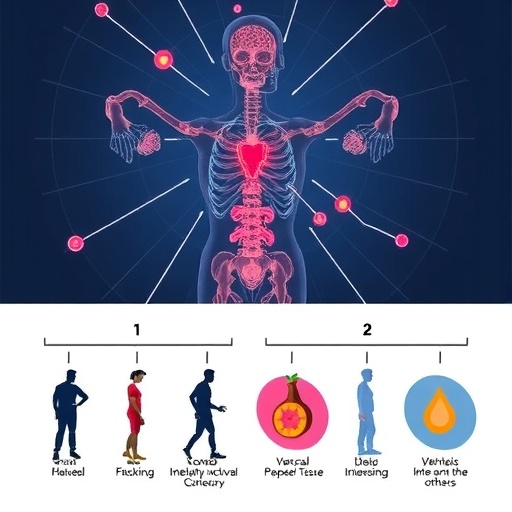In a transformative leap for adolescent reproductive health research, scientists now illuminate an intricate connection between metabolic inflammation within the hypothalamus and reproductive dysfunction. This emerging paradigm challenges conventional understanding, placing neuroinflammatory processes at the forefront of reproductive endocrinology. Recent findings unravel how metabolic-inflammatory signals disrupt hypothalamic regulation, precipitating profound consequences on the delicate hormonal orchestration necessary for healthy adolescent reproductive development.
For decades, reproductive endocrinology has largely emphasized peripheral factors such as gonadal hormones and their feedback loops, often underestimating central nervous system influences. However, the hypothalamus, a paramount neuroendocrine hub, governs the hypothalamic-pituitary-gonadal (HPG) axis, orchestrating puberty onset, menstrual cycles, and fertility. The novel research posits that inflammatory mediators triggered by metabolic imbalances in the hypothalamic milieu critically impair this regulatory center, leading to dysfunction manifesting as irregular cycles, delayed puberty, or infertility.
At a molecular level, inflammatory cytokines including tumor necrosis factor-alpha (TNF-α), interleukin-6 (IL-6), and other proinflammatory molecules accumulate within the arcuate nucleus and other hypothalamic nuclei responsible for pulsatile GnRH (gonadotropin-releasing hormone) secretion. This neuroinflammation disrupts GnRH neuron excitability and synaptic plasticity, leading to altered GnRH pulses essential for downstream pituitary release of LH (luteinizing hormone) and FSH (follicle-stimulating hormone). The aberrant signaling cascade undermines follicular development and steroidogenesis in the ovaries, thereby impairing reproductive capability.
Emerging evidence links excessive nutrient intake, obesity, and insulin resistance with the activation of hypothalamic microglia and astrocytes, cells traditionally considered supportive but now recognized as active immune modulators. This glial cell activation perpetuates a self-sustaining inflammatory loop within hypothalamic circuits. Particularly in adolescents, whose neuroendocrine systems are exquisitely sensitive during developmental windows, such metabolic inflammatory insults can disrupt the timing and quality of puberty—potentially provoking lifelong reproductive and metabolic sequelae.
Moreover, the interplay between metabolic hormone leptin and hypothalamic inflammation reveals a delicate balance governing energy homeostasis and reproductive health. Leptin, primarily secreted by adipose tissue, conveys nutritional status to the hypothalamus, acting as a permissive signal for puberty initiation. Inflammatory cytokine overexpression may induce leptin resistance at hypothalamic receptors, obscuring critical cues and derailing HPG axis function. This mechanistic synergy underscores why obesity and chronic low-grade inflammation increasingly correlate with adolescent reproductive disorders worldwide.
Crucially, this neuroinflammatory model extends beyond female reproductive health; males too exhibit disrupted hypothalamic regulation of gonadotropin secretion due to metabolic inflammation. Reduced testosterone levels, impaired spermatogenesis, and altered secondary sexual characteristics in adolescent boys with metabolic syndrome may all stem from similar hypothalamic derangements. These insights expand clinical awareness that adolescent metabolic health is inseparable from neuroendocrine reproductive function across sexes.
Therapeutically, these findings open vistas to novel interventions targeting hypothalamic inflammation. Current pharmacotherapies, largely aimed at peripheral endocrine glands, might be augmented or supplanted by agents modulating central neuroimmune pathways. Anti-inflammatory compounds, metabolic regulators improving insulin sensitivity, or even microglia-targeting biologics could emerge as groundbreaking treatments. Early identification of hypothalamic dysfunction biomarkers may enable precise prevention strategies in at-risk youth populations before irreversible reproductive damage ensues.
The utilization of advanced neuroimaging and molecular profiling technologies fortifies this research, enabling visualization and quantification of hypothalamic inflammation in vivo. Positron Emission Tomography (PET) imaging using novel tracers specific to activated microglia, combined with cerebrospinal fluid cytokine assays, provide empirical evidence supporting central inflammation’s role. These tools are instrumental in stratifying patients by inflammation status and monitoring therapeutic efficacy, heralding an era of personalized reproductive medicine.
Interdisciplinary collaborations between pediatric endocrinologists, immunologists, and neuroscientists have expedited these critical discoveries. The integration of metabolic science with reproductive endocrinology unearths complex crosstalk networks, demonstrating how systemic metabolic disturbances manifest within central neuroendocrine hubs. Such holistic approaches are indispensable for developing comprehensive models elucidating adolescent reproductive dysfunction etiologies.
Additionally, environmental factors, including exposure to endocrine-disrupting chemicals and psychosocial stressors, may exacerbate hypothalamic inflammation synergistically with metabolic conditions. Chronic stress activates hypothalamic-pituitary-adrenal (HPA) axis pathways, potentially compounding inflammatory cascades and further impairing HPG axis integrity. Understanding these multifactorial influences highlights the importance of addressing lifestyle, environmental, and psychological determinants alongside metabolic health.
From a public health perspective, these revelations stress the urgency of combating adolescent obesity and metabolic syndrome as prevention measures for reproductive disorders. Early lifestyle interventions promoting balanced nutrition and physical activity are vital in disrupting the cycle of hypothalamic inflammation and endocrine dysfunction. Pediatric healthcare providers must incorporate neuroendocrine risk assessments into routine adolescent evaluations to improve long-term reproductive outcomes.
In summary, metabolic inflammatory hypothalamic-induced reproductive dysfunction embodies a groundbreaking conceptual shift, positioning central neuroinflammation as a critical determinant of adolescent reproductive failure. This new paradigm elucidates the underpinnings of prevalent clinical phenotypes like hypogonadotropic hypogonadism and polycystic ovary syndrome through a neuroimmune lens. It simultaneously inspires innovative therapeutic strategies and reshapes preventive practices aimed at safeguarding reproductive health from adolescence into adulthood.
Future research directions include elucidating precise molecular signaling mechanisms underlying hypothalamic neuroimmune interactions, identifying genetic susceptibilities modulating inflammation-proneness, and exploring longitudinal impacts on reproductive lifespan. Understanding these pathways will unlock novel targets for intervention and refine diagnostic criteria for early-stage hypothalamic dysfunction.
Ultimately, the fusion of metabolic, inflammatory, and neuroendocrine sciences propels reproductive medicine into a new epoch of integrative physiology. As adolescent reproductive disorders surge globally alongside metabolic epidemics, such scientific advances hold profound implications for clinical practice, patient education, and health policy. This paradigm not only reshapes biomedical knowledge but also ignites hope for a future where adolescent reproductive health is preserved through precision neuroimmunometabolic care.
Subject of Research: The interplay between metabolic inflammation in the hypothalamus and adolescent reproductive dysfunction, focusing on neuroendocrine mechanisms underlying reproductive endocrine disorders.
Article Title: Metabolic inflammatory hypothalamic-induced reproductive dysfunction: a new paradigm in adolescent reproductive-endocrine health.
Article References:
Concepción-Zavaleta, M., Coronado-Arroyo, J., Quiroz-Aldave, J.E. et al. Metabolic inflammatory hypothalamic-induced reproductive dysfunction: a new paradigm in adolescent reproductive-endocrine health. World J Pediatr (2025). https://doi.org/10.1007/s12519-025-00961-z
Image Credits: AI Generated
DOI: https://doi.org/10.1007/s12519-025-00961-z




